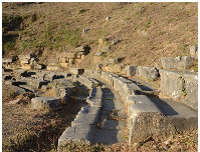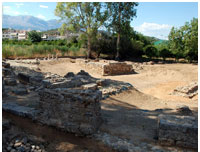Sparta
Sparta was a respected and most feared militaristic city-state in Ancient Greece. They dedicated their lives to the power of military, with a focus on quality of their warriors rather than quantity. Spartans were familiar with philosophy as they were aware of the importance of training the mind of a warrior, not only the body. They were also known for their literate verbal skills and poetry. It is said that the first love poems to women originated from Sparta. It was also the only city-state in Greece where women had elementary rights such as rights for inheritance, education, property and free speech. That was not all, it was also the first city-state to introduce land reform aimed at equalizing wealth among its citizens, but on the other hand claimed the rights of citizens to belong to the state upon their birth.
Unique political and social system
Spartans had a very unique political system consisting of two kings who took care of the military affairs, region improvements, such as roads and bridges, and were important religious figures. Now that reminds us of oligarchic government. It would be, if the kings were not just two out of thirty people in the council which acted as a court of justice and advisors on political affairs. The council consisted of, apart from the two kings with the most influence, twenty-eight people of rich families over the age of sixty. These elders were called the Gerontes and were elected by people. They also had a council of five people which acted as some sort of emergency fuse, because they had a power to indict the king. It is said that two Epochs, as they were called, always accompanied king on a campaign to protect the interests of the entire state. These Epochs were elected annually and any male citizen could become one, regardless of bloodline and wealth. Then there was the Assembly, like in Athens, where any male citizen over the age of thirty(eighteen in Athens) could participate at any time. They did the electing and discussed current affairs.
Apart from the two different bloodline families, from which the kings came, there were three different classes of people in the state of Laconia. There was an upper class of citizens which was considered for the original inhabitants of the region. That included both men and women even though women were not allowed to be elected in any form of government and to attend public assembly. Next in pyramid were the Perioeci who were free but non-citizen residents of Sparta. Unlike citizens of Sparta, they were free to travel to other states without any permission. They usually lived in suburbs of a city or in highlands and shores of the region. They were self-employed as traders, blacksmiths, craftsmen, shipwrights, etc...In a time of war they were immobilized to help the Spartans in various ways. At the bottom, there were slaves, called Helots, who had to work on a property of the citizens of Sparta. They had no rights whatsoever and were tied to the farms. They worked on agriculture as a majority and economically supported the citizens of Sparta. They were often humiliated, mistreated and even slaughtered by the citizens with no remorse.
Monuments of Ancient Sparta
Spartans believed that they themselves were monuments and therefore had no need to build extra buildings. However, later the Greeks built statues of Spartan warriors as a memory to these great people. Spartans themselves, however, did build a Temple of Artemis Orthia which was the main religious gathering place. There is also a statue of Leoniades at Thermopylae which was built at the site of the battle to honour the great king. They did have other, for that time, ordinary buldings, the remains of which can be found today.



